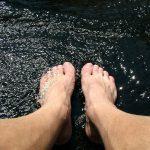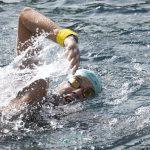
How can I train for speed when cold water swimming?
Swimming coach Cassie Patten has advice for cold water swimmers who want to continue their sprint training through the winter.
Outdoor Swimmer reader, Lizzy Powel, had this question for our resident swimming coach Cassie Pattern: “I am going to be swimming at the lake over the winter at least once a week as I am hoping to compete at the cold-water championships early next year. The question I have is, I find that I am not able to train for speed in the lake because I get too cold. Should I try to train in the pool to keep my speed up and then keep up my dips to keep the cold-water acclimatisation? If so, what should I be doing in the pool? This is my first year competing and I do not want to come last!”
The short answer is yes, I would recommend you swim your speed sessions in the pool and keep dipping as and when you want over the winter to be able to tolerate the cold temperatures. The training required to improve your sprinting speed usually consists of swimming short but intense sets, punctuated with sufficient rest. This type of training is not advisable to carry out in cold temperatures as the rest needed to recover will lead to your body getting cold and can lead to injury.
An example of a sprint main set
All 25m are 25m MAX, 25m recovery and the 300m are recovery focused on technique.
- 10 x 25m off 10 rest freestyle
- 300 pull focus on the hand entry and initial catch phase
- 8 x 25 off 15 rest number 1 stroke
- 3 x 100 as 50 drill 50 swim
- 8 x 25 off 20 rest
- 2 x 150 as 50 kick 100 swim
- 8 x 25 off 20 rest
- 300 count your strokes per 50 and try to hold as you go through the 300
- 2 x 25 both max off 30 rest
When sprinting, it is important to maintain a good technique. Do not rely on brute power and make your stroke look like an ice breaker! Think about the purchase you can gain from the catch phase; press the water backward with your forearm and don’t speed up so much that the water slips away from you.
That is why in the session I have included a technique focus in between the sprint sets. There are two reasons for this: firstly, as an active recovery and secondly, to remind your body and mind of the correct technique. One disadvantage of sprint training is it can take a long time to complete, here is another example to get a full sprint session completed in a small amount of time.
This set is to be completed eight times through all with fins on:
- 50m fast off 15 rest
- 2 x 25m fast off 15 rest
- 50 recovery, backstroke is preferable
The aim for this work out is to set your base line time on the first 50m then try to beat it over the next eight sets. The 2x 25m should consistently be faster than your 50 time. When sprinting wearing fins are an excellent tool to use as they allow you to swim faster and allow you to maintain your sprint speed over the whole set. Use short swim specific fins.
Having a set plan to stick to over the winter months is a fantastic way of keeping your mind focused and allowing you to maintain your fitness, so when you get back into open water or into competing season you already have a great base fitness.
Find more training sessions on Cassie Patten’s website WaveCrest Swimming. Read more training and technique stories.









